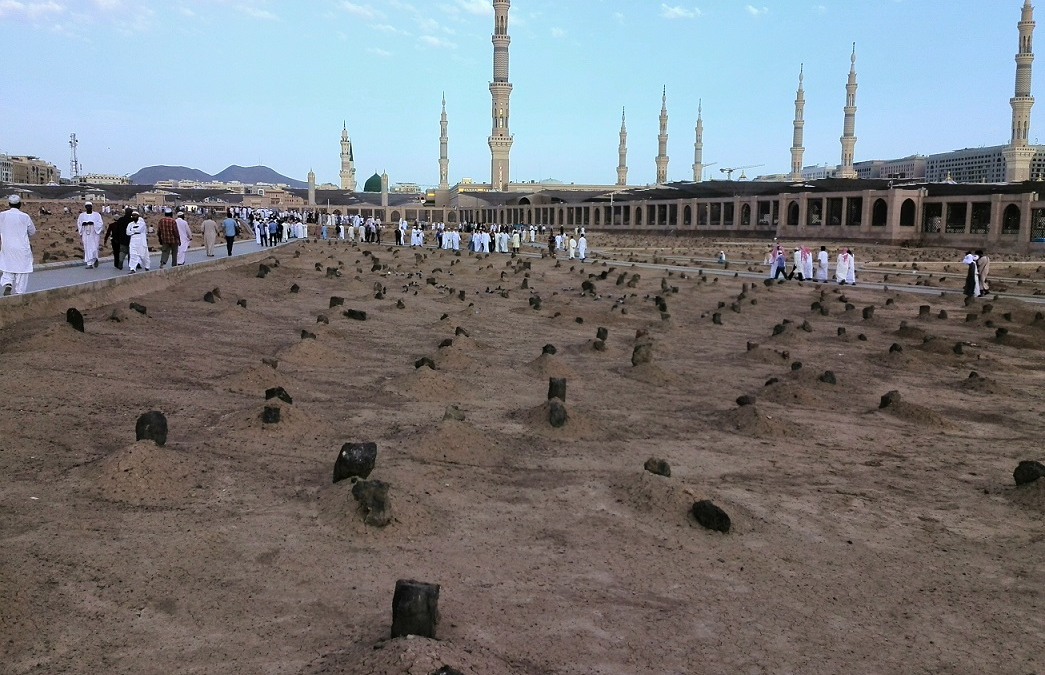By Asma Altaf
Jannat ul-Baqee also known as Baqee al-Gharqad is one of the most important and oldest cemetery in Medina. This is the first cemetery exclusively for Muslims.
This cemetery is located to the south-east of Masjid Al-Nabawi [The Mosque of Prophet Muhammad, (S)]. This is the resting place of many members of the Prophet’s household and his companions.
This place was chosen by the Prophet (S) himself and the first individual to be buried was Assad bin Zararah, a companion of Prophet Muhammad (S).
The famous personalities from Prophet Muhammad’s (S) Household that are buried there include:
- Fatima (sa), the daughter of Prophet Muhammad (S);
- Imam Hasan ibn Ali (‘a), the grandson of Prophet (S), the 2nd Infallible Imam;
- Imam Zaynul Abedin ibn Husayn (‘a), the grandson of Hazrat Ali (‘a) and Hazrat Fatima (sa), the 4th Infallible Imam;
- Imam Muhammad Al-Baqir (‘a), son of Imam Zaynul Abedin (‘a), the 5th Infallible Imam;
- Imam Ja’far Al-Sadiq (‘a), son of Imam Muhammad Al-Baqir (‘a), the 6th Infallible Imam;
- All wives of Prophet Muhammad (S), except Khadija bint Khuwaylid (sa);
- Hazrat Ibrahim (‘a), son of Prophet Muhammad (S) who died in infancy;
- Ruqqayah, Zainab and Um-Kulthum, daughters of Prophet Muhammad (S);
- Fatima bint Asad, aunt of Prophet Muhammad (S) and mother of Imam Ali (‘a);
- Safiya and Aatika, aunts of Prophet Muhammad (S);
- Abbas ibn Abdul Muttalib, uncle of Prophet Muhammad (S);
- Hazrat Fatima bint Hizam, also known as Ummul Baneen, wife of Imam Ali (‘a) [who got married to Imam Ali (‘a) after the death of Hazrat Fatima (sa)];
- Hazrat Abdullah ibn Ja’far Al-Tayyar, husband of Hazrat Zainab (sa) [The granddaughter of Prophet Muhammad (S)].
- Hazrat Aqeel ibn Abu Talib, elder brother of Imam Ali (‘a);
- Halima Sadiyah, the suckling mother and nurse of Prophet Muhammad (S).
Some other notable figures buried in Jannat ul Baqee are:
- Uthman ibn Affan, companion of Prophet Muhammad (S), the 3rd Khalifa;
- Hazrat Uthman bin Mouzun, companion of Prophet Muhammad (S);
- Some martyrs of the battle of Uhud;
- Malik ibn Anas, an Islamic jurist;
- Abdullah ibn Ma’sood;
- Abu Saeed Khudri;
- Muhammad Haya Al-Sindhi, a scholar;
- Muhammad Sayyid Tantawi, a scholar;
- Shaukat Ali Hayat, a scholar;
- Imam Shamil, Muslim leader and freedom fighter from the Caucuses;
- Idris of Libya, The King of Libya;
- Hassan As-Senussi, The crown prince of Libya;
- Muhammad Zakariya Kandhalawi, author of Fazael e Aa’maal;
- Nafi Al Madani, one of the ten readers of Quran;
- Abdulmecid II, the last Ottoman caliph.
Demolotion
In 1806, the Wahabbi army led by the sons of Muhammad Ibn Abdul Wahab (founder of wahabism/takfirism) and Muhammad Ibn Saud occupied Taif and began a bloody massacre. They targeted all the graves and religious structures in and around Jannat ul-Baqee.
The structures in Baqee were leveled to the ground and not a single dome was left standing. The occupation of the Holy sites and preventing Muslims from doing Hajj created a hue and cry among people which pressurized the Ottoman Empire to liberate and rebuild the holy places and once again permit the Muslims to perform the pilgrimage.
In 1818, an army led by Muhammad Ali Pasha, the Caliph’s viceroy of Egypt was sent to Medina where they defeated Wahabbis and as a result the Wahabbis left the Holy place.
The Prophet’s Mosque, the Baqee and other structures were rebuilt during the reign of Ottoman Sultans ‘Abd al Majid I’, ‘Abd al Hamid II’ and ‘Mahmud II’.
From 1848 to 1860, the buildings were renovated and the Ottomans built mosques and domes in a splendid aesthetic style.
They also rebuilt Al-Baqee with large domes over the graves of the Hazrat Fatima (sa), daughter of Prophet Muhammad (S), Imam Zaynul Abedin (‘a), Imam Muhammad Al-Baqir (‘a) and Imam Ja’far Al-Sadiq (‘a).
On April 21, 1925 (8th Shaban), the tombs in Jannat ul-Baqee were once again demolished and leveled to the ground leaving no traces of which grave belongs to whom.
The day is commemorated as Yawm al-Ghamm (The Day of Sorrow).
Every year on this day, people go out in processions demanding the rebuilding of the Holy sites. Despite the pressure worldwide, demolition of Holy sites under Al-Saud continue till today as Wahabbis claim they are trying to save the religion from what they consider idolatries and innovations in religion.
According to their false belief, they claim it is forbidden to construct monuments over graves and supplicate there. Despite all these propagandas and atrocities by Wahabbi Takfiris, as God promises of victory and conquest of Mecca, all the structures will be rebuilt soon and Muslims everywhere will visit to pay their allegiances to these noble personalities.
*****
For a more comprehensive history of the Holy Cemetery, visit:
https://www.al-islam.org/history-shrines/history-cemetery-jannat-al-baqi

